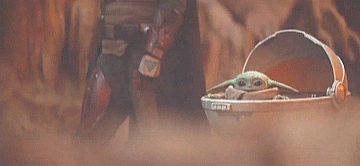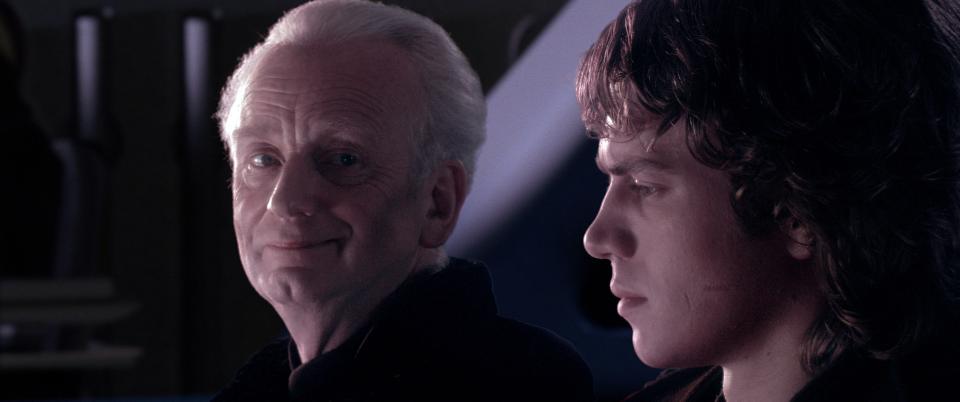Why The Rise of Skywalker Is So Frantic
The last installment of Disney's Star Wars trilogy takes a storytelling approach diametrically opposed to what made the original series good.
Spencer Kornhaber
I just wanted more elephant-walrus Coachella. Early in
The Rise of Skywalker, the final movie in Disney's main
Star Wars trilogy, the heroes travel to a desert planet where they encounter a sprawling bacchanalia populated by spongey-skinned aliens with tentacles dangling from their face. C-3PO informs them that it is the 'Festival of the Ancestors,' that it only happens about every 42 years, and that it is known for its colorful kites and delectable sweets. The other characters look exasperatedly at the droid. They're on a mission, and this exoplanet state fair happened to get in their way.
If only they could have slowed down. For a moment, it felt,
The Rise of Skywalker was about to dunk audiences into a very
Star Wars experience: falling in love with a sci-fi remix of our own planet's wonders as the characters hang out and get to know the locals. Rey sits with some piglet-like young creatures and watches a puppet show. Poe warns that spies might be among the crowd, which would seem to create a need for the characters to pay attention to their surroundings (think: the Day of the Dead sequence in the James Bond film
Spectre).The carnival on Pasaana might have joined the motley spaceport of Mos Eisley, the Jetsons beauty of Cloud City, the medieval sin den of Jabba's Palace, and other made-up George Lucas places that feel real to fans.
But then, vwomp. Rey is forced into a telepathic discussion with her rival Kylo Ren, who grabs her necklace across large expanses of space, uses it to determine her location, and dispatches Storm Troopers to chase her team into the desert in a scene that plagiarizes
Mad Max: Fury Road. The delectable sweets are never sampled.
Nothing stays put in
The Rise of Skywalker. J. J. Abrams, the director and one of the co-writers, picks up and ditches intriguing concepts so capriciously that viewers are left feeling as if they've watched someone sneeze on all the items at a fabulous buffet. This approach which is for want of a better word, completely manic, my colleague David Sims wrote is a big part of the negative critical reaction to the movie. But the wasteful use of settings, doodads, characters, and space horses does not just exhaust the audience. It also undermines the most essential prerogative of
Star Wars: world-building.
Lucas's original trilogy didn't fret all that much about having a clever plot. The arc from
A New Hope to
Return of the Jedi was a relatively clean and straightforward one about good guys struggling to overthrow bad ones, with limited detours to explore the consequential backstory of the main hero and main villain. Upon this sturdy spine, Lucas and his team draped exquisite set pieces set in interesting locations. The characters lingered in snow bases and treetop villages. The journey was absolutely as important as the destination.
World-building of that early
Star Wars sort is different from how world-building is often talked about today in blockbuster art, which is too caught up with internet-baiting downloads of backstory and mythology. The original films implied a grand, intricate history but did not dwell on the details of how, say, Luke Skywalker stayed hidden from his father for so long. One of the disastrous things about the early-2000s prequels was that Lucas felt driven to puzzle out too many hows and whys of the universe. The stories became knotty and bizarre because they became history lessons.
What's unsettling about Abrams's approach is its hybrid nature. He seems to acknowledge that a huge part of the
Star Wars magic is in envisioning dreamlike lands. But he also sees storytelling in the prequel-like terms of filling in blanks. He ends up with a movie that is information more than it is anything else. You can see this most clearly in the highly un-
Star Wars emphasis on MacGuffins, the screenwriting term for doohickeys the heroes chase after.
The term MacGuffin was popularized by Alfred Hitchcock, who described it as "the thing that the characters on the screen worry about but the audience [doesn't] care." Hitchcock thought the more boring the prize, the better; a 2008 Vanity Fair piece cited the ultimate example as "microfilm containing 'government secrets'" in Hitchcock's
North by Northwest. But Lucas somewhat disagreed with that version of MacGuffins and thought it was more effective to create treasures of real consequence, such as the Arc of the Covenant in Indiana Jones, which opened a channel to God. The droid R2-D2, who contained the plans for how to defeat the Death Star, was kind of the MacGuffin of A New Hope. But he was also a central character - and the secrets he contained directly and specifically determined what happened in the movie.
Abrams totally ditches Lucas's original approach on MacGuffins and opts for a cheaper version. In
Rise of Skywalker, viewers are introduced to Jedi Wayfinders, little holographic pyramids that, from a production-design standpoint, look like they belong in Magic: The Gathering rather than in
Star Wars. There's also an important dagger outfitted with two different esoteric maps. The way that the villains and heroes frantically battle throughout the movie for these objects makes them resemble recent blockbuster MacGuffins like
The Avengers' Infinity Stones and Harry Potter's Horcruxes. But at least those objects were long-discussed in their respective universes and were understood to contain great power. In
Rise of Skywalker, the Wayfinders and the dagger serve the purpose of delivering historical trivia surrounding the Force while moving the characters from point A to points B, C, T, and Z.
The way that Abrams reduces
Star Wars to a treasure hunt adds greater amounts of the arbitrary and nonsensical into the viewing experience. The aforementioned dagger is found in a cave that the heroes ever so conveniently fall into (you're not allowed to complain about ridiculous coincidences in Abrams's
Star Wars films - the Force has Awakened!). One Wayfinder was hiding on some unnamed planet that Kylo Ren is shown slicing through in the early moments of the film. The disposability of the objects and the context of their discoveries make it obvious that they are inventions of the filmmaker, not native parts of the universe on the screen. These MacGuffins, thus, perform world-unbuilding. They are glitches in fiction's illusion of reality.
There is, to be sure, a larger narrative encasing these flaky hijinks: The Resistance needs to stop the First Final Order from conquering everyone. But if the viewer cares at all about that mission, it is in spite of Abrams's treatment of the people and places at stake. Early in the film, Poe sends the Millennium Falcon 'lightspeed skipping,' which means the spaceship flashes for a few second in one world, then another, then another. The sequence sets the silly and frenetic tone of the movie. It also highlights the scale of the galaxy that, a long time ago, used to be
Star Wars' greatest asset. Surely the whirling, flimsily motivated storytelling of this sequel represents how Hollywood is changing: The tentpole movie is a catalog, and if anything in it caught your eye, a corresponding TV show, video game, comic, or plastic toy will be eventually be ready for consumption.
https://www.theatlantic.com/enterta...s-rise-skywalker-gives-world-building/604000/































